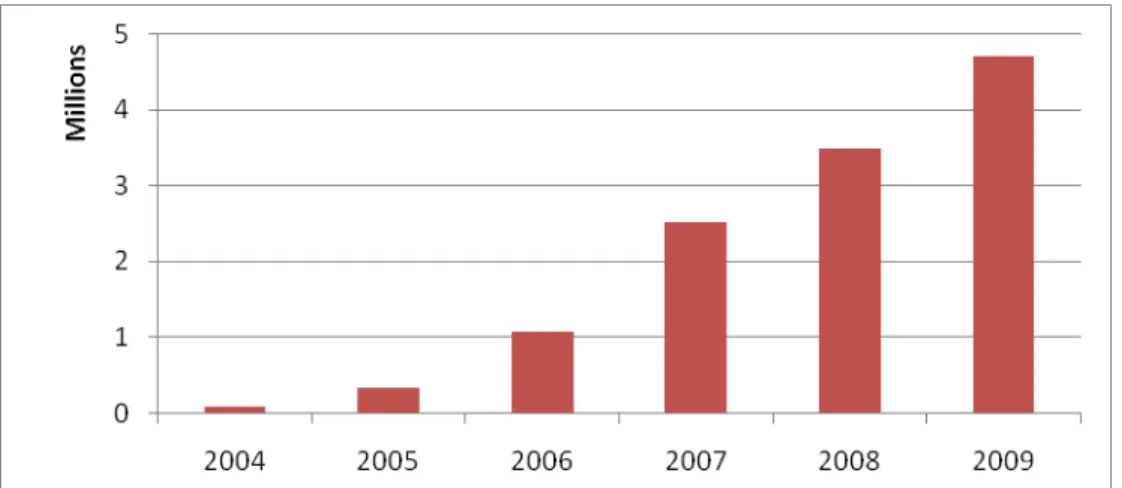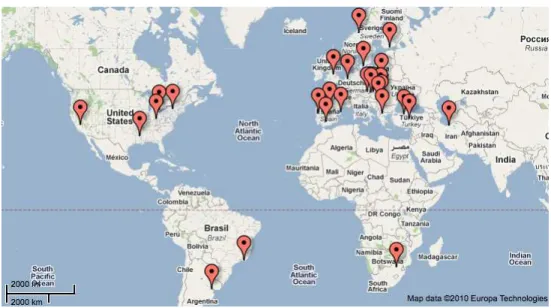1
Gaining momentum: GeoGebra
inspires educators and students
around the world
Markus Hohenwarter
Mathematics Education
Kepler University Linz, Austria
markus@geogebra.org
Zsolt Lavicza
Faculty of Education
University of Cambridge, UK
zsolt@geogebra.org
Introduction
The use of te h ology is slo ly e o i g a su sta tial part of today’s edu atio . Although
due to the increased accessibility of affordable computing technologies in the 1980s and 90s it was predicted that computers would become rapidly integrated into mathematics teaching and learning (Kaput, 1992), technology uptake in schools has been considerably slow. The current expansion of technology use took a new unconventional direction: a bottom-up, community-based collaborative development, catalysed by Internet-based communities and increasingly available community-developed software packages. During the past decades it has been demonstrated that a large number of enthusiasts can alter conventional thinking and models of development and innovation. The success of open source projects like Linux, Firefox, Moodle, and Wikipedia shows that collaboration and sharing can produce valuable resources in a variety of areas of life. While working on the open-source project GeoGebra we are witnessing the emergence of an enthusiastic international community around the software.
2
local members know best what their community needs. During the past two years IGI and the GeoGebra community have been gaining substantial momentum and this book is partly the result of successful local initiatives.
In this article, we will offer a brief outline of the history, the current state of GeoGebra, and plans for future developments.
History of GeoGebra
The software GeoGebra originated in the master's thesis project of Markus Hohenwarter at the University of Salzburg in 2002. It was designed to combine features of dynamic geometry software (e.g. Cabri Geometry, Geometer's Sketchpad) and computer algebra systems (e.g. Derive, Maple) in a single, integrated, and easy-to-use system for teaching and learning mathematics (Hohenwarter & Preiner, 2007b). During the past years, GeoGebra has developed into an open-source project with a group of 15 developers and over 100 translators all over the world. The latest version of GeoGebra offers dynamically linked multiple representations for mathematical objects (Hohenwarter & Jones, 2007) through its graphical, algebraic, and spreadsheet views. GeoGebra, which is currently available in 50 languages, has received several educational software awards in Europe and the USA (e.g. EASA 2002, digita 2004, Comenius 2004, eTwinning 2006, AECT 2008, BETT 2009 finalist, eureleA 2009 finalist, TechAwards 2009). Apart from the standalone application, GeoGebra also allows the creation of interactive web pages with embedded applets (Hohenwarter & Preiner, 2007a). These targeted learning and demonstration environments are freely shared by mathematics educators on collaborative online platforms like the GeoGebraWiki (www.geogebra.org/wiki). Si e 2004, the u er of isitors to GeoGe ra’s e site has
increased from 7000 per month to currently over half a million per month (Figure 1) coming from 190 countries.
3
International GeoGebra Institute
To be able to better assist the GeoGebra community through its rapid growth we established IGI at the end of 2007. The four principal aims of IGI are to 1) offer teacher training and support; 2) develop teaching materials and the software; 3) conduct research; 4) outreach to less well-off communities. IGI is essentially an umbrella organisation for local GeoGebra Institutes (GI) established by teachers and researchers at universities and teacher education institutions (Hohenwarter & Lavicza, 2007). Local GeoGebra Institutes agree to follow the aims of IGI, but the emphasis of their work depends on their local needs, interests, and priorities. Currently, there are 27 local GIs in 20 countries (Figure 2) and all of them are doing a valuable and diverse work for the GeoGebra community.
Figure 2: Map of local GeoGebra Institutes
The development of the international community has been also catalysed by the new GeoGebra website (http://geogebra.org) where local Institutes and community members can post their meetings and workshops. There are numerous GeoGebra workshops offered at various conferences as well as there will be at least seven specialised GeoGebra conferences in 2010 in Europe, North America, and Asia. Furthermore, owing to the good work of local GIs there are hundreds of well-trained (certified in most cases) GeoGebra trainers who support teachers in their communities.
4
Future and Vision
The growth of the GeoGebra community necessitated the expansion and organization of educational resources and ways to share materials within the community. Below, we describe three project categories that aim to address these issues. The software has been constantly improved, but there are new directions to which we aim to develop the software. In addition, it is important for the community to be able to offer support for teachers and students in less well-off countries.
Open Educational Resources
GeoGebraTube
GeoGebraTube aims to create an online platform to share, rate, and comment interactive GeoGebra web pages and constructions (a kind of YouTube for free GeoGebra materials). This will be the successor of the current GeoGebraWiki material pool (www.geogebra.org/wiki). In GeoGebraTube, it should be possible to upload materials directly from within GeoGebra to make it very easy for all our users to contribute free content. Simple metadata should make it easy to find materials for different grade levels, topics, and languages.
GeoGebraResources
The GeoGebraWiki already contains thousands of worksheets/exercises shared by teachers and students from all over the world. These resources are somewhat organized (self organized by the community), but it would need a more rigorous system to make these resources well organized and easily searchable. This project would help to channel already existing resources into GeoGebraTube and would develop methods for organization and ensuring resource quality. In addition to the GeoGebraWiki, there is an enormous number of resources existing on the Internet. This project will also investigate how these resources could be connected with other open educational resources platforms.
GeoGebraExercises
This project attempts to create interactive applets ("mathlets") that generate random questions, require the student to answer the question (e.g. by typing an answer, dragging points), and provide feedback to the student (e.g. visually or in words). The answer checking is done using a mixture of JavaScript and GeoGebra (including GeoGebra's symbolic algebra system). These interactive applets can then be imported as a SCORM package into a Learning Management System (e. g. Moodle) and the scores will be recorded. The level can go from very basic (e. g. fractions) to advanced (e. g. calculus) and the aim is to cover the whole secondary curriculum.
Software Development
GeoGebra3D
5
in the GeoGebra standalone application as well as offer the possibility to be embedded into interactive web pages.
GeoGebraCAS
Extend the computer algebra system (CAS) features of GeoGebra to allow students to work with symbolic objects like fractions, equations, and formulas that include variables. This new Symbolic Algebra View should be easy to use by students starting at age 12. In particular, we will need to develop and include an equation editor that allows easy input of fractions, square roots, etc.
GeoGebraSpreadsheet
Extend the capabilities of the existing GeoGebra Spreadsheet View. In particular, create a specific toolbar for spreadsheet commands to allow easy use with the mouse and an additional tool to load the spreadsheet with data sets provided by teachers and textbook authors. For diagrams, we should have wizard dialogs that let you create diagrams like line graphs or bar charts by choosing from various options. These wizards would also take
ad a tage of GeoGe ra’s po erful statistical routines to analyze spreadsheet data. Another dialog box would present the user with hyperlinks to data from external sources or local files. With this capability a simple mouse click could bring data from science and mathematics textbooks into GeoGebra, ready to be explored by students.
GeoGebraTouch
GeoGebraTouch intends to create a version of GeoGebra that can be used solely with a pen or your fingers on a touch screen computer or interactive whiteboard. A virtual keyboard needs to be added that can be used in many of our over 50 supported languages. Also, the current GeoGebra user interface needs to be adapted to allow easy control with a pen or finger.
Outreach
As an open source project, GeoGebra tries to specifically reach out to users in developing countries who may not be able to afford to pay for software. Together with colleagues in Costa Rica, Egypt, the Philippines, and South Africa we are currently investigating possibilities of setting up user groups, GeoGebra Institutes, and how to best support local projects. Involving colleagues in our international network could open new opportunities for supporting countries with limited resources and exchange educational resources and experiences.
Summary
6
Acknowledgements
We would like to thank the editors of this book for offering a great opportunity to further develop the GeoGebra community and add valuable resources.
References
Hohenwarter, M., & Jones, K. (2007) Ways of linking geometry and algebra: the case of GeoGebra. Proceedings of the British Society for Research into Learning Mathematics. 27(3):126-131, University of Northampton, UK: BSRLM.
Hohenwarter, M., & Lavicza, Z. (2007) Mathematics teacher development with ICT: towards an International GeoGebra Institute. Proceedings of the British Society for Research into Learning Mathematics. 27(3):49-54. University of Northampton, UK: BSRLM.
Hohenwarter, M., & Preiner, J. (2007a) Creating mathlets with open source tools. Journal of Online Mathematics and its Applications. ID 1574, vol. 7, August 2007.
Hohenwarter, M., & Preiner, J. (2007b). Dynamic mathematics with GeoGebra. Journal of Online Mathematics and its Applications. ID 1448, vol. 7, March 2007.

